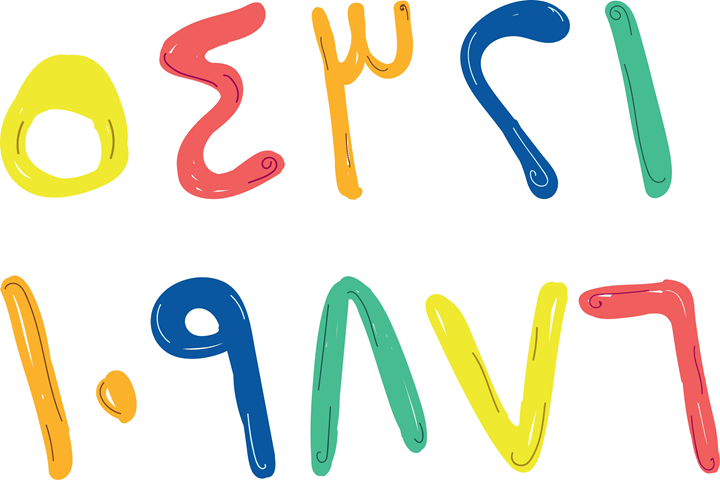Welcome to a crucial and often challenging aspect of Arabic: Arabic numbers grammar! Unlike English, where numbers rarely change for gender, Arabic numbers have specific rules, especially regarding agreement with the noun they count. If you’ve ever wondered about Arabic numbers masculine and feminine forms, or how to correctly say Arabic numbers 20-30 or Arabic numbers 30-40, this guide is for you! We’ll break down the essential Arabic rules of grammar for numbers, from Arabic language 1 to 10 and beyond, making this complex topic clear and manageable.
The Foundation: Arabic Language 1 to 10
Let’s start with the basics. The rules for numbers 1 and 2 are different from numbers 3 through 10.
Numbers 1 (وَاحِد – wāḥid) and 2 (اِثْنَان – ithnān):
These numbers agree in gender with the noun they describe.
- 1:
- One (masculine): وَاحِد (wāḥid) – for masculine nouns
- One (feminine): وَاحِدَة (wāḥidah) – for feminine nouns
- Example: قَلَمٌ وَاحِدٌ (qalamun wāḥidun) – one pen (masc.)
- Example: طَاوِلَةٌ وَاحِدَةٌ (ṭāwilatun wāḥidatun) – one table (fem.)
- 2:
- Two (masculine): اِثْنَان (ithnān)
- Two (feminine): اِثْنَتَان (ithnatān)
- Example: قَلَمَانِ اِثْنَانِ (qalamāni ithnāni) – two pens (masc.)
- Example: طَاوِلَتَانِ اِثْنَتَانِ (ṭāwilatāni ithnatāni) – two tables (fem.)
Numbers 3 (ثَلَاثَة – thalāthah) to 10 (عَشَرَة – ʿasharah): The “Reverse Gender” Rule
This is the most crucial rule in Arabic numbers grammar for beginners: Numbers from 3 to 10 disagree in gender with the noun they count.
- If the noun is masculine, the number takes the feminine form (ending in ة – tāʾ marbūṭah).
- If the noun is feminine, the number takes the masculine form (no tāʾ marbūṭah).
- The counted noun is in the plural genitive case.
Let’s see Arabic numbers masculine and feminine in action for 3-10:
| Number | Masculine Noun (feminine number form) | Feminine Noun (masculine number form) |
|---|---|---|
| 3 | ثَلَاثَةُ أَقْلَامٍ (thalāthatu aqlāmin) – 3 pens | ثَلَاثُ طَاوِلَاتٍ (thalāthu ṭāwilātin) – 3 tables |
| 4 | أَرْبَعَةُ كُتُبٍ (arbaʿatu kutubin) – 4 books | أَرْبَعُ سَيَّارَاتٍ (arbaʿu sayyārātin) – 4 cars |
| 5 | خَمْسَةُ رِجَالٍ (khamsatu rijālin) – 5 men | خَمْسُ نِسَاءٍ (khamsu nisāʾin) – 5 women |
This “reverse gender” rule is a key component of Arabic rules of grammar for numbers!
The Teens: Numbers 11 (أَحَدَ عَشَرَ – aḥada ʿashara) to 19 (تِسْعَةَ عَشَرَ – tisʿata ʿashara)
For numbers 11 to 19, both parts of the number generally agree in gender with the counted noun. The counted noun is singular and in the accusative case.
- Example: eleven pens (both parts masculine, noun masculine) – أَحَدَ عَشَرَ قَلَمًا (aḥada ʿashara qalaman)
- Example: eleven tables (both parts feminine, noun feminine) – إِحْدَى عَشْرَةَ طَاوِلَةً (iḥdā ʿashrata ṭāwilatan)
Stepping Up: Arabic Numbers 20-30
When we move to the tens, the rules become slightly different, but consistent.
- The Tens (20, 30, etc.): The tens themselves (عِشْرُونَ – ʿishrūn for 20, ثَلَاثُونَ – thalāthūn for 30) do not change for gender. They are always in the masculine plural form.
- Compound Numbers (21-29): These are formed by saying the unit first, then “and” (وَ – wa), then the ten.
- The unit part (1-9) follows its own gender rule (1 and 2 agree; 3-9 disagree).
- The counted noun is singular and in the accusative case.
Let’s look at Arabic numbers 20-30 with examples:
- 20: عِشْرُونَ (ʿishrūn)
- twenty books (masc.) – عِشْرُونَ كِتَابًا (ʿishrūna kitāban)
- twenty tables (fem.) – عِشْرُونَ طَاوِلَةً (ʿishrūna ṭāwilatan)
- 21 (masc. noun): وَاحِدٌ وَعِشْرُونَ قَلَمًا (wāḥidun wa ʿishrūna qalaman) – twenty-one pens
- 21 (fem. noun): وَاحِدَةٌ وَعِشْرُونَ طَاوِلَةً (wāḥidatun wa ʿishrūna ṭāwilatan) – twenty-one tables
- 23 (masc. noun): ثَلَاثَةٌ وَعِشْرُونَ كِتَابًا (thalāthatun wa ʿishrūna kitāban) – twenty-three books (number part ‘3’ is feminine, noun is masculine)
- 23 (fem. noun): ثَلَاثٌ وَعِشْرُونَ سَيَّارَةً (thalāthun wa ʿishrūna sayyāratan) – twenty-three cars (number part ‘3’ is masculine, noun is feminine)
Continuing the Pattern: Arabic Numbers 30-40 and Beyond
The same pattern for compound numbers continues for Arabic numbers 30-40 and all subsequent tens (40, 50, 60, 70, 80, 90).
- 30: ثَلَاثُونَ (thalāthūn)
- thirty students (masc.) – ثَلَاثُونَ طَالِبًا (thalāthūna ṭāliban)
- thirty female students (fem.) – ثَلَاثُونَ طَالِبَةً (thalāthūna ṭālibatan)
- 35 (masc. noun): خَمْسَةٌ وَثَلَاثُونَ كِتَابًا (khamsatun wa thalāthūna kitāban) – thirty-five books (number part ‘5’ is feminine, noun is masculine)
- 35 (fem. noun): خَمْسٌ وَثَلَاثُونَ سَيَّارَةً (khamsun wa thalāthūna sayyāratan) – thirty-five cars (number part ‘5’ is masculine, noun is feminine)
Why Mastering Arabic Numbers Grammar is Essential
Understanding these Arabic rules of grammar for numbers is crucial because:
- Accuracy: Incorrect gender agreement is a common mistake for learners and can sometimes lead to misunderstanding.
- Clarity: Proper usage ensures your meaning is precise.
- Fluency: Confident use of numbers contributes significantly to overall fluency and sounding natural.
The initial complexity of Arabic numbers grammar, especially the “reverse gender” rule, is a common hurdle, but with consistent practice and clear examples, you’ll master Arabic numbers masculine and feminine forms in no time.
Ready to count like a native and confidently use Arabic language 1 to 10 and beyond? Visit www.kaleela.com and download the Kaleela Arabic learning app today! Our comprehensive lessons provide clear explanations and engaging exercises to help you master Arabic numbers grammar and all other essential aspects of the language. Start counting with confidence!



